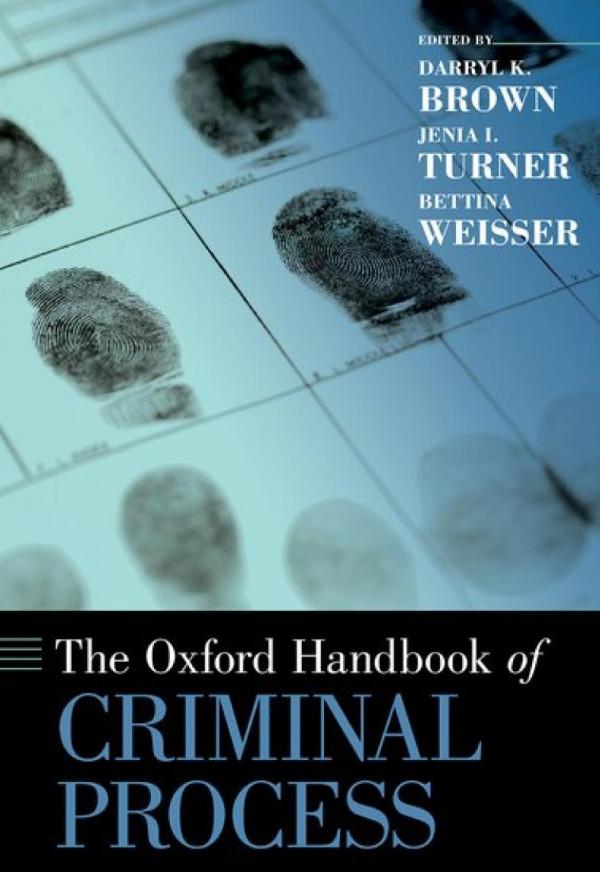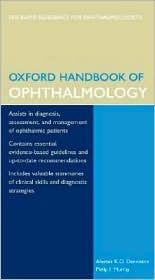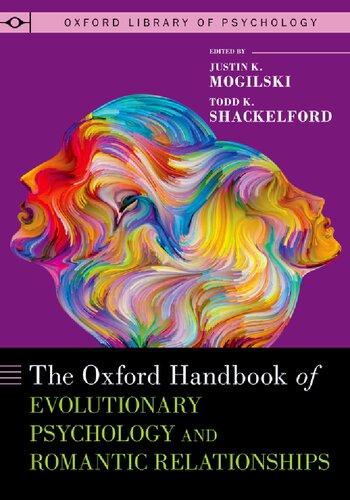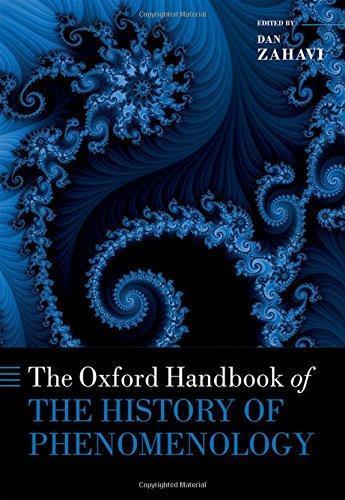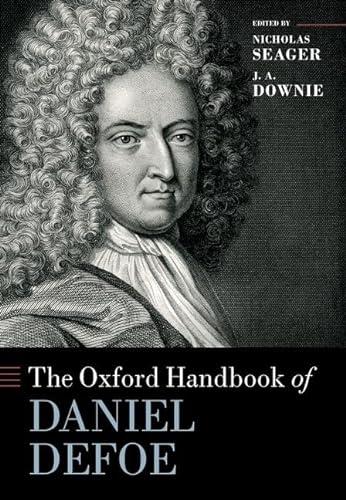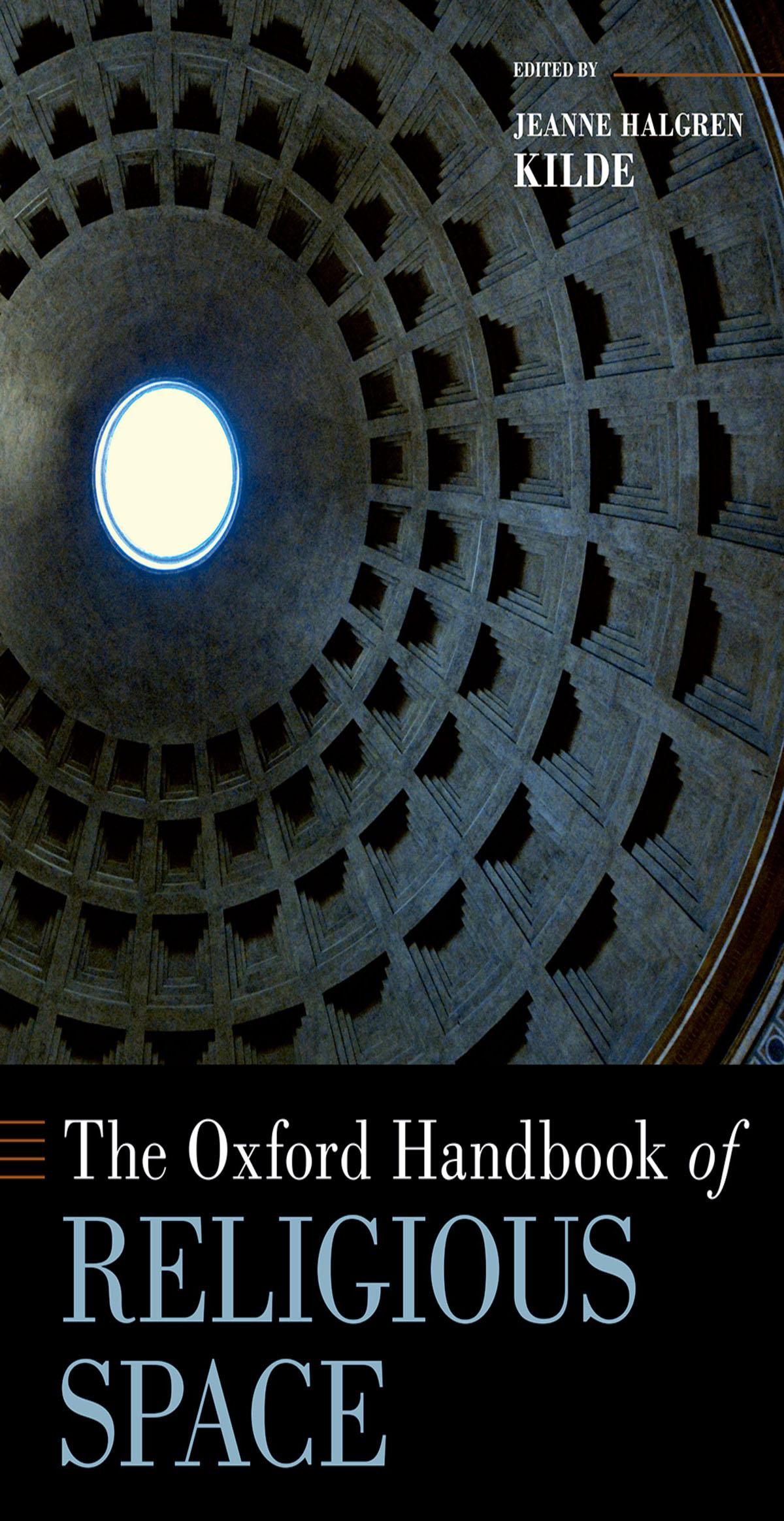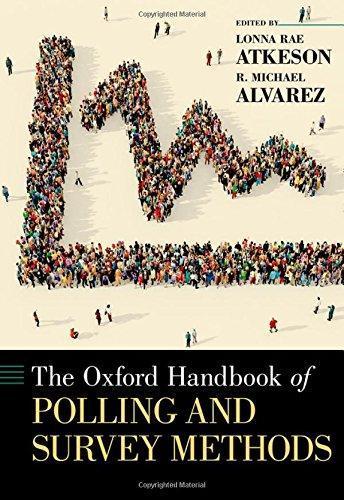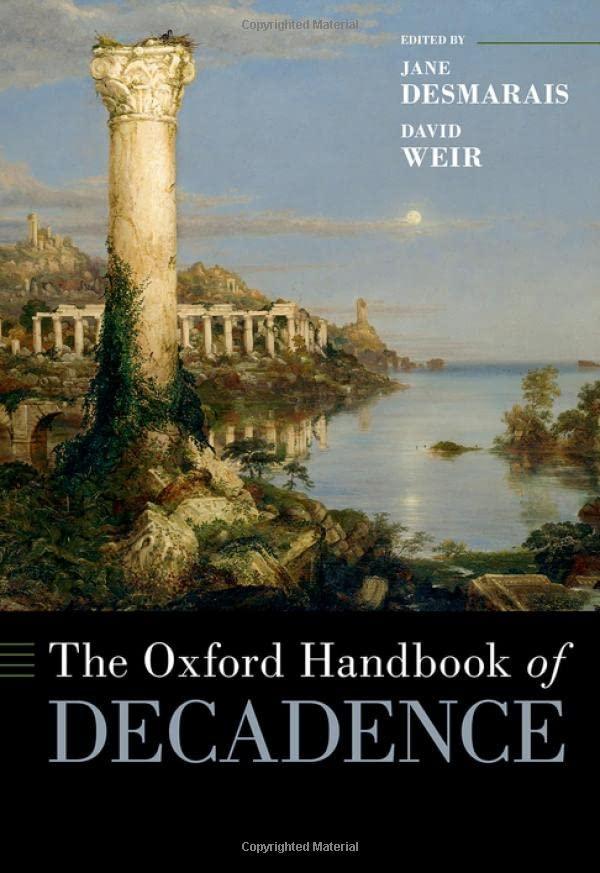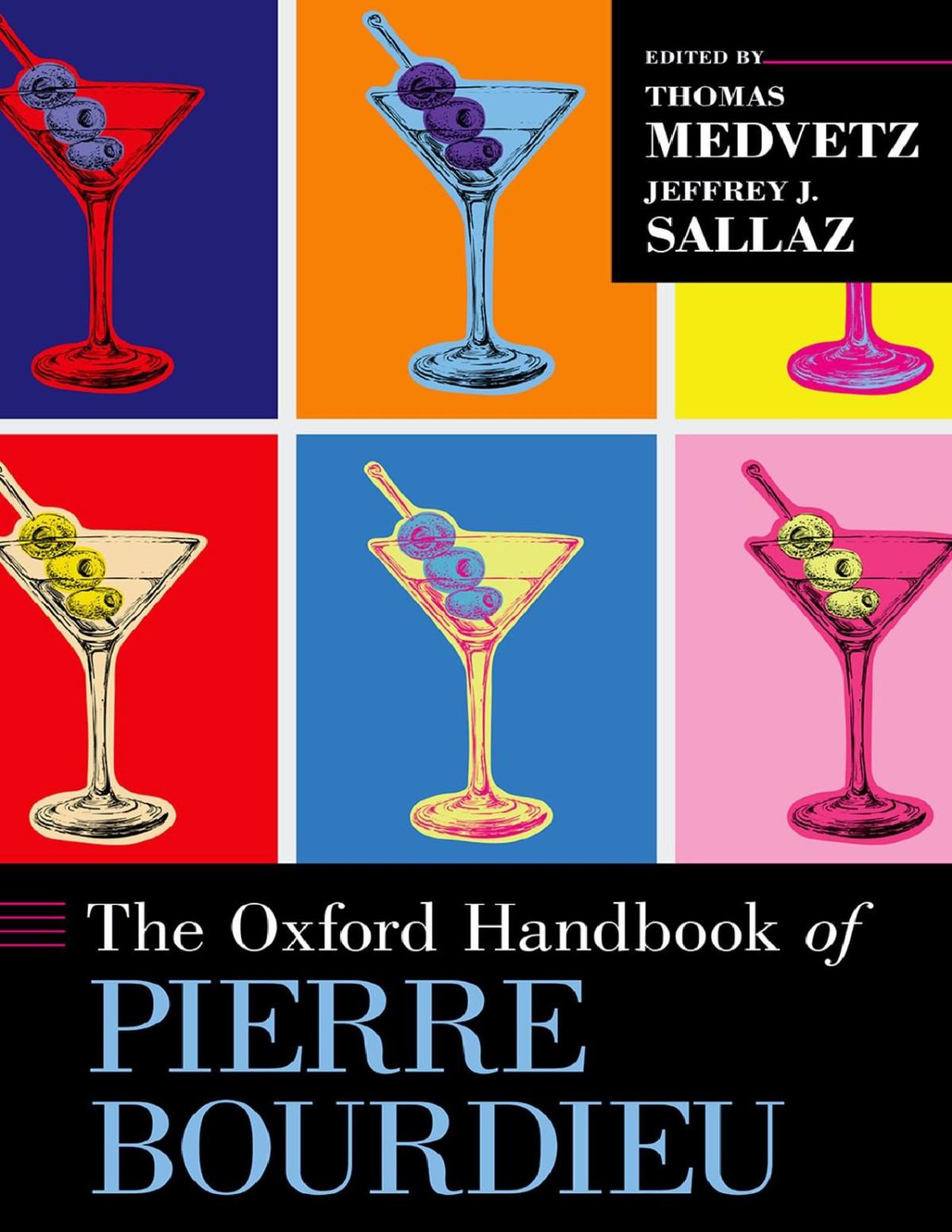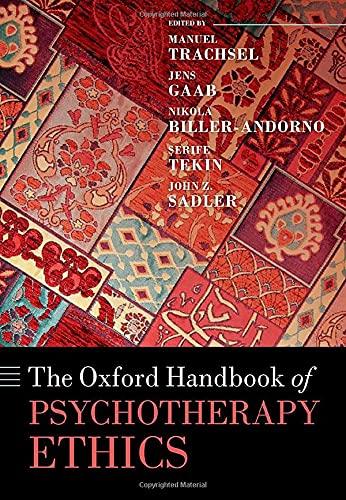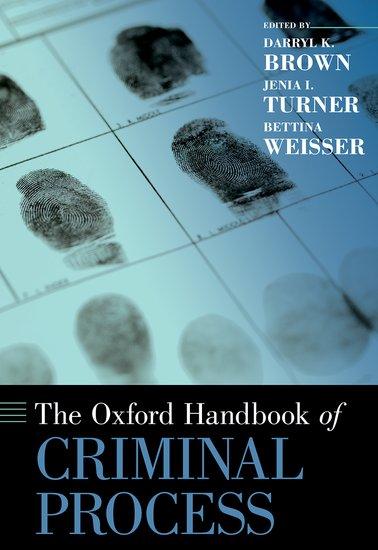The Oxford Handbook of Criminal Process Darryl K Brown
Visit to download the full and correct content document: https://ebookmass.com/product/the-oxford-handbook-of-criminal-process-darryl-k-bro wn/
More products digital (pdf, epub, mobi) instant download maybe you interests ...
Oxford Handbook of Ophthalmology Alastair K. O. Denniston
https://ebookmass.com/product/oxford-handbook-of-ophthalmologyalastair-k-o-denniston/
The Oxford Handbook of Evolutionary Psychology and Romantic Relationships Justin K. Mogilski (Editor)
https://ebookmass.com/product/the-oxford-handbook-ofevolutionary-psychology-and-romantic-relationships-justin-kmogilski-editor/
The Oxford Handbook of the History Phenomenology (Oxford Handbooks)
https://ebookmass.com/product/the-oxford-handbook-of-the-historyphenomenology-oxford-handbooks/
The Oxford Handbook of Daniel Defoe (Oxford Handbooks) Seager
https://ebookmass.com/product/the-oxford-handbook-of-danieldefoe-oxford-handbooks-seager/
The Oxford Handbook of Religious Space Jeanne Halgren Kilde
https://ebookmass.com/product/the-oxford-handbook-of-religiousspace-jeanne-halgren-kilde-2/
The Oxford Handbook of Polling and Survey Methods (Oxford Handbooks)
https://ebookmass.com/product/the-oxford-handbook-of-polling-andsurvey-methods-oxford-handbooks/
The Oxford Handbook of Decadence Jane Desmarais
https://ebookmass.com/product/the-oxford-handbook-of-decadencejane-desmarais/
The Oxford Handbook of Pierre Bourdieu Unknown
https://ebookmass.com/product/the-oxford-handbook-of-pierrebourdieu-unknown/
The Oxford Handbook of Psychotherapy Ethics Trachsel
https://ebookmass.com/product/the-oxford-handbook-ofpsychotherapy-ethics-trachsel/
Copyright Page
Edited by Darryl K. Brown, Jenia I. Turner, and Bettina Weisser
The Oxford Handbook of Criminal Process
Edited by Darryl K. Brown, Jenia Iontcheva Turner, and Bettina Weisser
Print Publication Date: Apr 2019
Subject: Law Online Publication Date: Feb 2019
Copyright Page
Oxford University Press is a department of the University of Oxford. It furthers the University’s objective of excellence in research, scholarship, and education by publishing worldwide. Oxford is a registered trade mark of Oxford University Press in the UK and certain other countries.
Published in the United States of America by Oxford University Press
198 Madison Avenue, New York, NY 10016, United States of America.
© Oxford University Press
All rights reserved. No part of this publication may be reproduced, stored in a retrieval system, or transmitted, in any form or by any means, without the prior permission in writing of Oxford University Press, or as expressly permitted by law, by license, or under terms agreed with the appropriate reproduction rights organization. Inquiries concerning reproduction outside the scope of the above should be sent to the Rights Department, Oxford University Press, at the address above.
You must not circulate this work in any other form and you must impose this same condition on any acquirer.
Library of Congress Cataloging-in-Publication Data
Names: Brown, Darryl K., editor. | Turner, Jenia I., editor. | Weisser, Bettina, editor.
Title: The Oxford handbook of criminal process/Darryl K. Brown, Jenia I. Turner, Bettina Weisser.
Description: New York: Oxford University Press, 2019. | Includes bibliographical references and index.
Copyright Page
Identifiers: LCCN 2018027958| ISBN 9780190659837 ((hardback): alk. paper) | ISBN 9780190659844 ((paperback): alk. paper)
Subjects: LCSH: Criminal procedure. | Criminal law. | Criminal justice, Administration of. | Criminal procedure—European Union countries. Classification: LCC K5401 .B76 2019 | DDC 345/.05—dc23 LC record available at https://lccn.loc.gov/2018027958
Note to Readers
This publication is designed to provide accurate and authoritative information in regard to the subject matter covered. It is based upon sources believed to be accurate and reliable and is intended to be current as of the time it was written. It is sold with the understanding that the publisher is not engaged in rendering legal, accounting, or other professional services. If legal advice or other expert assistance is required, the services of a competent professional person should be sought. Also, to confirm that the information has not been affected or changed by recent developments, traditional legal research techniques should be used, including checking primary sources where appropriate.
(Based on the Declaration of Principles jointly adopted by a Committee of the American Bar Association and a Committee of Publishers and Associations.)
You may order this or any other Oxford University Press publication by visiting the Oxford University Press website atwww.oup.com.
1 3 5 7 9 8 6 4 2
Printed by Sheridan Books, Inc., United States of America
Notes on the Contributors
Edited by Darryl K. Brown, Jenia I. Turner, and Bettina Weisser
The Oxford Handbook of Criminal Process
Edited by Darryl K. Brown, Jenia Iontcheva Turner, and Bettina Weisser
Print Publication Date: Apr 2019 Subject: Law Online Publication Date: Feb 2019
Notes on the Contributors
Lorena Bachmaier,
Professor of Law, Universidad Complutense, Madrid
Martin Böse,
Professor of Criminal Law, Criminal Procedure, International and European Criminal Law, Director of the Institute of Criminal Law, University of Bonn
Darryl K. Brown,
O.M. Vicars Professor of Law and Barron F. Black Research Professor, University of Virginia School of Law
Michele Caianiello,
Professor and Dean of the Department of Legal Studies, University of Bologna
Ed Cape,
Emeritus Professor of Criminal Law and Practice, University of the West of England, Bristol Meike M. de Boer,
Former Trainee, Netherlands Institute for the Study of Crime and Law Enforcement
David Dixon,
Professor of Law, University of New South Wales
Markus D. Dubber,
Professor of Law and Director, Centre for Ethics, University of Toronto
Gary Edmond,
Professor of Law at the University of New South Wales and Research Professor (fractional) at Northumbria University
Helen Fenwick,
Professor of Law and Director of the Human Rights Centre, Durham University
Richard D. Friedman,
Alene and Allan F. Smith Professor of Law, University of Michigan
Brandon Garrett,
L. Neil Williams, Jr., Professor of Law, Duke University School of Law
Gwladys Gilliéron,
Associate Professor in Criminal Law and Criminology, University of Zurich
Sabine Gless,
Professor of Criminal Law and Criminal Procedure, University of Basel
Johanna Göhler,
Research Associate, Institute for Foreign and International Criminal Law, University of Cologne
Elisabetta Grande,
Professor of Comparative Law, Università degli Studi del Piemonte Orientale
(p. xii) Valerie P. Hans,
Professor of Law, Cornell University
Rebecca K. Helm,
Lecturer in Law, University of Exeter Law School
Jacqueline S. Hodgson,
Professor of Law, University of Warwick
Tatjana Hörnle,
Professor of Criminal Law, Legal Philosophy and Comparative Criminal Law, Humboldt University, Berlin
John Jackson,
Professor of Comparative Criminal Law and Procedure, University of Nottingham, School of Law
Maria Kaiafa-Gbandi,
Professor of Criminal Law, Director of the Research Institute for Transparency, Corruption and Financial Crime, Aristotle University of Thessaloniki
André Klip,
Professor of Criminal Law, Criminal Procedure and the Transnational Aspects of Criminal Law, Maastricht University
Ho Hock Lai,
Amaladass Professor of Criminal Justice, National University of Singapore
Katalin Ligeti,
Professor of Law, University of Luxembourg
Richard L. Lippke,
Professor, Department of Criminal Justice, Indiana University
Marijke Malsch,
Senior Researcher, Netherlands Institute for the Study of Crime and Law Enforcement; Lecturer, VU University Amsterdam
Marie Manikis,
Assistant Professor of Law, McGill University
Nicola McGarrity,
Senior Lecturer and Director of the Terrorism Law Reform Project, University of New South Wales
Bernadette McSherry,
Professor of Law and Foundation Director, Melbourne Social Equity Institute, University of Melbourne
Grischa Merkel,
Professor of Law and Ethics, University of Basel
Valsamis Mitsilegas,
Professor of European Criminal Law and Global Security and Deputy Dean for Global Engagement (Europe), Queen Mary University of London
Yu Mou,
Lecturer in Criminal Law, SOAS, University of London
Neil Richards,
Thomas & Karole Green Professor of Law and Director of the Institute for Policy in Medicine and Law, Washington University
Kent Roach,
Professor of Law and Prichard Wilson Chair in Law and Public Policy, University of Toronto
Paul Roberts,
Professor of Criminal Jurisprudence, University of Nottingham, School of Law
Jacqueline E. Ross,
Prentice H. Marshall Professor of Law, University of Illinois College of Law
(p. xiii) Helmut Satzger,
Professor of Law, Director of the Chair of German, European and International Criminal Law and Criminal Procedure as well as Business Criminal Law, LudwigMaximilians-Universität, Munich
Carl-Friedrich Stuckenberg,
Professor of German and International Criminal Law and Criminal Procedure, Comparative Criminal Law, and Criminal Law History, University of Bonn
Elisavet Symeonidou-Kastanidou,
Professor of Criminal Law, Dean of the Faculty of Law, Aristotle University of Thes
saloniki
Stephen C. Thaman,
Professor of Law, Emeritus, Saint Louis University
Juliette Tricot,
Centre de Droit Pénal et de Criminologie, University of Paris Nanterre
Jenia I. Turner,
Amy Abboud Ware Centennial Professor in Criminal Law, Dedman School of Law, Southern Methodist University
Mary Vogel,
Professor of Law, Chair in Criminal Law, University of Manchester
Joëlle Vuille,
Senior Researcher, School of Criminal Justice, University of Lausanne
Michael Washington,
Fellow, Washington University Institute for Policy in Medicine and Law
Thomas Weigend,
Professor of Criminal Law (ret.), University of Cologne
Bettina Weisser,
Professor of Criminal Law, Director of the Institute for Foreign and International Criminal Law, University of Cologne
Frank Zimmermann,
Postdoctoral Research Fellow, Ludwig-Maximilians-Universität, Munich
II. Dual Penal State
Dual penal state analysis is one aspect of dual state analysis, which in turns illustrates critical analysis of law, a contextual interdisciplinary approach to legal studies. Underlying, and driving, these various scholarly enterprises is the distinction between law and police as modes of modern state governance.2
(p. 6) Critical analysis of law, and dual penal state analysis as an application, attempts to overcome unproductive categorical distinctions between traditional (doctrinal, intradisciplinary) and “modern” (interdisciplinary), “common law,” and “civil law” conceptions of legal studies in general, and criminal law in particular. Ultimately, critical analysis of law pragmatically pursues the aim of transforming legal scholarship into a communal, transnational enterprise of engaged scholarship, that marshals the collective competence of scholars trained in law to tackle the pressing issue of vigilantly observing and critiquing the exercise of state power—and state penal power—through law in a modern liberal democratic state.
Critical analysis of law subjects the exercise of state power through law to internal and external critique. Internal critique tests the comprehensiveness, coherence, and consistency of legal norms, much as traditional doctrinalism has done for decades (though more flexibly and contextually). External critique, more important and interesting, leaves the positivistic constraints of traditional doctrinalism behind and critiques state action in the name of law in light of normative commitments associated with the modern liberal conception of law.
Rather than treat these commitments as if they were handed down ready-made and fully formed by some deus ex machina or other, critical analysis of law regards them as historically and contextually situated. In particular, it views the modern conception of law and its attendant normative commitments as having arisen, or rather having been actively constructed, in contradistinction to an alternative mode of governance. State power as law was legitimate, just; state power as police was alegitimate, ajust. The absence of legal norms did not imply the absence of all norms. But policial norms did not affect the legitimacy or justice of state power through police; instead, they were framed as advisory maxims of prudence, wisdom, efficiency, rationality, addressed to sovereign state householders who might decide to allow their unlimited discretion to be guided by them. Violations of principles of law (or “legality”) threatened the state’s legitimacy; deviations from self-adopted and self-policed maxims of police did not, and could not, because the idea of a critique of the legitimacy of the sovereign state householder was inapposite.
The very notion of a critical analysis of state power was regarded, and presented, as novel. Since the seventeenth century, a police science had developed that generated an everbroadening stream of analysis and advice on the ever-more complex tasks of governing the state household, ranging from Machiavelli’s proto-policial ruminations on princely statecraft to the tomes and compendiums on “good police” produced by eighteenth-century Polizeiwissenschaft and “political oeconomy” in Germany and France (and, by Adam
Smith and Patrick Colquhoun, in Scotland and London). But none of these texts concerned itself with questions of “legitimacy,” whatever this would have meant. They were manuals on good governance, or rather good housekeeping, contributions to the longstanding genre of oikonomia and Hausväterliteratur on the grand, public scale of the state.3
(p. 7) To appreciate the historical context, and the elements of continuity and disruption, of the construction, and appearance, of the modern notion of law, it helps to assume the perspective of the longue durée. Law and police, and law in contradistinction to police as an alternative mode of governance, is the modern manifestation of the basic distinction between autonomy and heteronomy, or self- and other-government. This is the continuity. The autonomy of modern law, however, is not the autonomy of the few (the householder/ governor/subject) but the autonomy of all (persons as such). This is the disruption. With the discovery, or pronouncement (or invention4), of the autonomy of the person as such, with autonomy now serving as the universal characteristic (or, more precisely, the capacity) shared by all rather than the marker of distinction that categorically separated the few (householders) from the rest (household), the traditional accommodation between autonomy and heteronomy collapsed. Autonomy had turned from making government patently possible to making it facially illegitimate.
The modern concept of law, in this view, appears as the response to the Enlightenment’s challenge of universal-personal autonomy in the political sphere. The legitimacy of modern state power through law turns on its compliance with the Grundnorm of autonomy; legitimate government is self-government, all the way down.
Just what this ideal means, and how one might go about implementing it is anything but obvious, of course. In fact, the history of the legal-political project in modern Western liberal democratic states can be seen as a history of the struggle to answer these questions. But this is only one, if common, way of telling the story. Regarding modern Western legalpolitical history as a series of progressive attempts to better implement the vision of liberal law, and autonomous government, risks viewing it through a narrow, Whiggish, lens that focuses on only one mode of state governance, law, as if the declaration that “Law is King” (Thomas Paine) swept away centuries, or millennia, of quasi-patriarchal governance on the household model. This view is Whiggish even if one rejects its crude and most familiarly suspect version, which sees constant progress toward liberal perfection. The exclusive focus on law is Whiggish, no matter in what version, insofar as it takes the launch of the modern legal-political project to mark the beginning of a shift from one analytic framework to another, from police to law, rather than the evolution of a two-track framework that reflects the persistence of the long-standing tension between autonomy and heteronomy, now modernized and sharpened to the point of facial illegitimacy in the tension between law and police. The modern liberal state is not defined by one mode of governance (law) with exceptions defined only as such; instead, the apparent exceptions in turn reflect an alternative mode of governance (police) that stands in uncomfortable
tension with the “new” mode of governance (law) that is presented not only as dominant but as exclusive, as the (only) norm.
Dual penal state analysis, as the most urgent instance of dual state analysis, then, pursues a parallel analysis of state power from both perspectives, law and police. This means at least two things. First, each mode of governance, and its attendant mode of analysis, is (p. 8) defined in terms of the other and, ultimately, in terms of the tension between autonomy and heteronomy. Law and police are not two concepts that “exist” independently of one another and might happen, occasionally, to overlap. They are inextricably linked, through the “modern” historical moment of their emergence (law state versus police state) and their longue durée grounding in the interplay between autonomy and heteronomy in classical Athens (agora versus oikos).
Second, dual penal state analysis always considers the possibility that an apparent exception to the norm of a supposedly exclusive (or merely dominant) mode of governance may in fact reflect another mode of governance altogether. Instead of continuously recording the inconsistency of a given state norm, practice, or institution with some legal “principle” or other, for instance, dual penal state analysis instead asks the preliminary question of whether that critique is simply inapposite because the state action in question is conceived as a matter of police, rather than as a matter of law. It is beside the point to note, again and again, that, say, criminal liability for possession flies in the face of fundamental principles of criminal law (actus reus, most obviously) if possession offenses perform a key role in a comprehensive penal police regime designed to permit state officials to exercise their essentially unlimited and unreviewable discretion to identify and incapacitate “offenders”—individuals or groups who give offense in the specific sense of disturbing the king’s, or later on the public’s, peace (in the lingo of English or American criminal law) or are “disturbers” (Störer) who “compromise public safety and order” (in the lingo of German “police law”).5
It’s important here to recognize that dual penal state analysis is just that, a critical analysis of the state’s penal power as a whole from the perspectives of law and police. The entire penal regime is subject to this two-track analysis in all of its nooks and crannies, down to the level of specific doctrinal features (such as the crime of possession). Contrast this with an attempt to identify specific legal or policial aspects or elements that add up to a legal-policial checkerboard regime. While it is certainly possible, and in fact likely, that individual features of the penal regime may align more easily with one mode of penal governance than another (possession, again, provides an example), it is important not to lose sight of the fundamental nature of the tension between law and police. Identifying and then eliminating particular “policial remnants” within a penal law regime will not resolve the tension or eliminate police as a type of penal governmentality any more than announcing that the birth of the law state killed off the police state.
The persistence of policial governmentality and therefore of the fundamental tension between law and police as modes of governance has frequently been suppressed, or denied, rather than acknowledged and addressed. In Germany, and other European countries, the
once sprawling and eventually all-encompassing field of police science vanished over the course of the nineteenth century. Rather than analyzing the operation of the state as an oeconomic household manifesting its police power, attention shifted to the study of the supposed legal limits of that awesome sovereign power in a brand new (p. 9) legal discipline: administrative law (including, most explicitly, in Germany, the subdiscipline of “police law”). Police scientists turned into administrative law scholars, if not overnight, then from one tome to the next;6 the legalization of police was achieved as soon as it was named, never mind that the new courts of administrative law, whether or not they were considered part of the administrative apparatus, could at best occasionally police the margins of the vast administrative regime of the modern state, which continued to grow in scope and complexity unconcerned with, if not aided by, the rebranding of the state from police state to law state. The administrative state continued to be defined by discretion through and through, with supposed law constraints coming in the shape of formal guidelines, rarely enforced and, if so, always with an eye toward retaining the essential discretion at the core of the administrative enterprise. In the end, it might appear that rather than law legalizing police, police policified law: administrative “law” did not place law-appropriate and legitimacy-based constraints on administrative police, but was integrated into it, and appropriated by it.
Across the Atlantic, there was no American police science; as a result, there was nothing to dismantle or rebrand. In fact, the notion of police power (if not police science) played an explicitly central role in the American federalist compromise. Defined by its indefinability, utterly discretionary and all-encompassing, it was the governmental manifestation of sovereignty. To be sovereign meant to have the power to police, the “power to govern men and things within the limits of its dominion.”7 To say that the states retained their sovereignty therefore was to say that they retained the power to police. At the same time, and for the same reason, the federal “government” did not, and could never, have that flexibly all-devouring oeconomic power that would have reduced the states to members of the national state household under the discretionary power of a national state householder, a presidential patriarch. Originary state sovereignty would have become delegated sovereignty, the limits of which drawn and then policed at the discretion of the national state householder (ultra vires).
And yet, while it served the federalist compromise (at least on paper, if not in fact, as the federal government soon went about knitting together an all-encompassing de facto police power from its various “enumerated” powers) to marvel at, and insist on, the limitless awesomeness of state sovereign power within the new federalist structure, this very feature of the police power also brought into stark relief its apparent incompatibility with the presumably even more awesome, though strictly limited, law power in a country where the Law is King.
This incompatibility, however, was merely apparent. For it turned out that the police power and the law power rested on radically different conceptions of the objects of state power, and their relation to its subjects. The incompatibility of law and police is, at bottom, the incompatibility of autonomy and heteronomy. Autonomy and heteronomy are incom
patible only if the distinction between governor/subject and governed/object has (p. 10) been abandoned. If, however, there are objects of governance who lack the capacity for autonomy and therefore are regarded as mere objects, rather than also as potential subjects, of state power, the tension between autonomy and heteronomy can be managed as it had been for millennia, through the logic of the relationship between householder and household, between governor and governed, according to entirely discretionary prudential maxims of good governance.
The only question in this accommodation was where the distinction between subject and object should be drawn, who would end up on which side of the sovereign divide. Initially, women, children, slaves, and the poor fell on the object side of the divide, along with—for our purposes particularly interesting—criminal offenders. It has long been American blackletter law that the state’s penal power is an instance of the police power. This meant, as we saw, that criminal law was—and remains—primarily a matter of state law, with federal law treated as a narrow specialized supplement (a fiction increasingly difficult to maintain as federal criminal law dramatically expanded). The power to punish was seen as intimately connected to the very idea of sovereignty; if a sovereign must have any power, it must be the power to punish those who give offense, by challenging his sovereignty or, since the Middle Ages, by breaking his (household) peace.
While the supposed “localness” (i.e., stateness) of the police power within the federalist arrangement got—and continues to get—the bulk of the attention, its intimate connection to the sovereignty of the householder, which reaches back through the Middle Ages to the beginnings of Western political history in classical Greece, captures its heteronomous governmentality, a mode of governance that connects the Athenian oikos to the Roman familia to the medieval mund to the early modern King’s peace to the early modern state’s “good police” (gute Policey) and eventually “public safety and order.”
The criminal offender remains outside the scope of the modern legal-political project associated with the liberal ideal of law as the mode of state governance that rejects the radical distinction between governor and governed and instead turns on the radical identity of all persons as potential subject-objects of autonomous government. Criminal offenders personify the object of disciplinary power that threatens the subject’s sovereignty. They are the paradigmatic object of police power and, as such, beyond the scope of law power. Their crime is a police offense: the status of being a threat to sovereign power, as opposed to the act of violating the autonomy of another person, say. Disciplining them, at the discretion of the householder-sovereign, reasserts the householder-sovereign’s authority, and in this way reaffirms the radical distinction between governor and governed, householder and household. By contrast, in a liberal law-based conception of crime, the paradigmatic crime would be interpersonal, rather than anti-statal, and punishment (rather than hierarchical discipline) would reassert the identity of victim and offender, and ultimately—through the construction of self-government and -punishment—also the identity of punisher and offender.
This isn’t the place to lay out a detailed parallel account of penal law and penal police, or the results of a critical analysis of the penal state from the perspectives of law and police. Instead, let’s move on to a two-track analysis of criminal process in the dual penal state in comparative-historical perspective, by focusing on Germany and the United States.
(p. 11)
III. Germany
The first issue that a comparative analysis of dual penal state regimes should address is whether the comparators are relevantly similar. Insofar as dual penal state analysis draws on the liberal conception of law, it makes no sense to apply it to a state that doesn’t regard—or represent—itself as participating in the modern legal-political project.
Germany is generally assumed to clearly fit this bill. This may be surprising, given Germany’s more than checkered legal-political history, even if the Nazi period is presented as a radically anomalous episode after which the German penal regime resumed the pursuit of the ideal of liberal criminal law, or perhaps is regarded as a sort of prolonged stress test that, in the end, illustrated the principled steadfastness of German criminal law science, which survived the period (remarkably) unscathed, by and large.
There is much more to be said (and much more than has been said) on the place of the Nazi era in German criminal legal history—for instance, on the continuity between pre-1933 proposals implemented by the Nazis and Nazi reforms that remained in force post-1945. But, for present purposes, let’s stick with how German criminal law tends be regarded in Germany (including among the German criminal law professoriate, i.e., the practitioners of German criminal law science) and in the many other countries—not only (or even primarily) in Europe, but also elsewhere (including, notably, in East Asia and much of Latin America)—that assign to it a certain model status.
In this view, foundational figures of German criminal law played a key role in recognizing and formulating the central challenge of state penal power in the modern law state, not only in Germany but for the liberal legal-project as a whole. According to this account, Kant is the single most important figure in what Schneewind called the invention of autonomy,8 the central innovation of the Enlightenment and the centerpiece of “modern” moral and political philosophy. While Kant’s own musings about the state’s power to punish tend to receive less attention than one might expect (presumably because they might be considered radically inconsistent with the “modern” conception of state penal power their author is said to have inaugurated), one of his contemporary admirers, Paul Johann Anselm Feuerbach, is widely considered the “father” of modern German criminal law. It’s at least unclear to what extent Feuerbach’s views on criminal law9 are faithful to Kant’s views on the subject (whatever that would mean given Kant’s either vaguely suggestive or specifically troubling remarks) or instead hew closer to those of Kant’s consequentialist nemesis, Beccaria, whose pamphlet Of Crimes and Punishments (1764) so profoundly influenced thinking and writing on state punishment (p. 12) that authors as otherwise violently opposed as Blackstone, Bentham, and Jefferson were content to simply cite, if not directly quote, Beccaria’s definitive pronouncements as theoretical preambles to their
own writings (which then again might differ radically not only from each other but also in their connection to Beccaria’s general theory).10
Feuerbach, as a Kantian-Beccarian, is off to a bit of a rough start as father of German criminal law. Kant certainly considered Beccaria’s views on punishment diametrically opposed to his own, and Beccaria and Kant ever since have been used as convenient standins for the centuries-long fight between “consequentialist” and “retributivist” theories of punishment. Anyone who thought otherwise, then, and promulgated a Kantian-Beccarian account of criminal law would run the risk of being suspected of having failed to grasp the basic thrust of either view (or both) unless that person had a fairly involved story to tell that would account for their compatibility.
There is the additional problem that, taking Kant seriously, Beccaria is not only wrong, but wrong in the very sense that concerns us here: the conception of law grounded in the invention of autonomy as the distinctive characteristic of all persons as such. The problem with the utilitarian position, on this view, is precisely that it fails to regard the objects of punishment as persons endowed with the capacity for autonomy, but as slaves to their experience and anticipation of pain or pleasure who are properly governed through the threat and infliction of pain, as “a man who lifts his stick to a dog” (as Hegel put it a little later) or, as we might say, as a householder who disciplines a mere human household resource.
It turns out, however, that Beccaria and Kant did agree on one point: the classification of criminal offenders as slaves (of the state) and their punishment as enslavement.11 “Consequentialist” or “retributivist,” these two paragons of Enlightened penality saw nothing incompatible or troubling in regarding and treating the objects of state penal power as paragons of heteronomy. This may be more surprising in Kant’s case, given his association with an autonomy-based conception of personhood, but in either case it raises disquieting questions about the very foundation of the modern liberal legal-penal project, across the supposedly fundamental consequentialist-retributive/Beccarian-Kantian divide.
It appears, then, that from the very start the supposedly all-inclusive, radically egalitarian Enlightenment project of state power through law in general, and through penal law in particular, countenanced a distinction so basic and ingrained as to have escaped critical reflection: the radical distinction between persons and offenders that tracks the boundary of the legal-political project. Fichte, unlike Hegel, enthusiastically pursued (p. 13) this exclusionary aspect of Kant’s view, which generally does not figure in the orthodox narrative of a Kant-based evolution of modern criminal law.12
More important for our purposes, penal enslavement figures prominently in Feuerbach’s work, particularly in his work on the Bavarian criminal code of 1813, hailed as the first modern German criminal code, if not the first modern criminal code, period. Only recently has German historiography begun to note this feature of Feuerbach’s codification work, after decades of largely unadulterated adulation. Even the most casual reader of Feuerbach’s draft could hardly miss Feuerbach’s detailed descriptions of all aspects of the design and infliction of various brutal penal measures, including permanent “civil
death” made real through solitary confinement, during which the penal slave wears “on both feet a long chain with a heavy iron ball.” That Feuerbach is not alone in endorsing penal enslavement (or, in Thomas Jefferson’s case, literally penal measures cribbed from medieval dooms in the original Anglo-Saxon) merely shifts focus from Feuerbach, the “father” of German criminal law and criminal codification, to the liberal legal-political project of state penal power itself.
But let’s assume, for purposes of our quick comparative look at the dual penal state in Germany and the United States, that the challenge of liberal state penal power was indeed framed explicitly and comprehensively in Germany, starting with a potent combination of philosophical reflection and jurisprudential-doctrinal implementation associated with the work of Kant and Feuerbach (along with contributions by Hegel, if not Fichte) during the long turn of the nineteenth century. The discovery, or invention, of autonomy as the distinctive characteristic of personhood implied a fundamental critique not only of morality but also of politics. State power was legitimate only insofar as it was conceived of, and exercised through, law as the mode of governance that regarded the objects of government as persons capable of self-government, rather than as mere objects of quasipatriarchal (even if benevolent) police power. Penal power posed the greatest challenge to the legitimacy of state power, and penal law both manifested and answered that challenge (still captured by Franz von Liszt’s slogan a century later that “the criminal law is the magna charta of the criminal law”).
To recognize, and to frame, the paradox of modern state penal power, however, is not the same as addressing it, never mind resolving it. We’ve already noted the surprising unwillingness to subject the founding texts of liberal penal state power to serious critical scrutiny. Beccaria and Kant each framed their—otherwise diametrically opposed—Enlightened conception of state punishment in a way that, with what now appears as a brazen sleight of hand, excluded key aspects of the penal regime from its legitimatory reach. To put it differently, Beccaria’s and Kant’s ideals of modern state penal power already contain the radical distinction among objects of penal power that marks the dual penal state.
(p. 14) Meeting the challenge of legitimating penal power in a modern liberal state, however, requires not only scrutinizing the foundational texts that set out the challenge and point the way to its resolution. It also requires constantly testing existing penal norms, practices, and institutions against the relevant legitimatory norm. Whether this essential process of ongoing legitimacy scrutiny continues to this day in Germany is at least debatable. Since the nineteenth century, German legal scholarship has seen itself as being engaged in a self-consciously positivistic enterprise of “legal science.” Since 1871, German criminal legal science revolves around the German criminal code, and pursues a comprehensive project of constructing a doctrinal system ostensibly based on, or at least constrained by, the code (which, however, is short, incomplete, and vague enough to leave considerable room for scientific maneuvering). A parallel, similarly positivistic, though far less ambitious, doctrinalist project concerns itself with the (considerably more detailed) 1878 German code of criminal procedure. In general, this vast multigenerational doctrinalist criminal law project is self-contained, with critical analysis confined to concerns
about coherence, comprehensiveness, and consistency, rather than tackling fundamental questions of legitimacy. The state’s power to punish, instead, is taken for granted and, for some time now, the challenge has been one of doctrinal refinement, rather than of continuous legitimacy scrutiny.
Lay participation, for instance, has long been considered at best pointless and at worst problematic because, while it might have acted as a check on state power in the nineteenth century, officials of the German law state (judges and prosecutors) have long been independent enough to no longer require such scrutiny. In fact, lay participants are regarded as injecting an element of irrationality and incompetence into an essentially rational and competent legal process run by state officials trained in German legal science. The independent jury was abandoned several decades ago; and even the lay participants in the remaining “mixed” courts are less appreciated than tolerated, largely because it is an open secret that their role in the criminal process is largely ceremonial (despite the startling fact that they have the power, and the numbers, to outvote professional judges, a power they never exercise).
If we again assume that German criminal law, thanks to Kant and Feuerbach (with a somewhat incongruous assist by Beccaria), saw and formulated the novel challenge of legitimacy posed by the very notion of the threat and use of penal violence by the state against its own autonomous constituents, the continued legitimation of the state’s penal power has fallen into desuetude because the recognition and framing of a problem has been confused with its solution. The legitimation of state penal power in a modern liberal democratic state requires its continuous fundamental critique, not the complacent sense that the legitimacy question has been asked and answered as long as two centuries ago.
The legitimacy of state penal power can never be definitively settled in a modern liberal state grounded in the autonomy of its constituents. There is no such thing as a once-andfor-all systemic legitimation of state penal power. The design of the penal regime is, of course, crucial for the legitimation of the violence that is threatened and (p. 15) inflicted under it, but it is not sufficient. The actual interference with the autonomy of specific state constituents in every aspect, substantive and procedural, personal and institutional, of every case must be justified in terms of the legitimatory Grundnorm (autonomy).13
An internal conception of legal science that (ostensibly) limits itself to rearranging the doctrinal furniture on the assumption that legitimatory questions have been resolved, then and forever, may become indistinguishable from the statist project of police science that the launch of the law state rendered anachronistic and relabeled as “administrative law” (or “police law”). Legal scholarship that pursues legal science as positivistic doctrinalism, with a brief (again ostensibly) limited to the ever more correct rationalization of state norms (most important, but not limited to, the criminal code), functions as an organ of good governance whose collective advice may, or may not, find the ear of state officials, without the uncomfortable suggestion that the issue of legitimacy, rather than of more prudent administration, might be at stake. Criminal law scholarship thus conceived
may amount to science (in some limited, technical sense), but it would not amount to legal science in the modern sense of law.
Finally, consider the German penal state from the perspective of the distinction between substantive and procedural criminal law. In German criminal law, substance has long been privileged over process. The bulk of legislative, jurisprudential, and scholarly attention has been devoted to the substantive norms of criminal law, and more specifically to the general principles of criminal liability (the general part of criminal law) that apply to all criminal offenses (which make up the so-called special part). Kant showed very little interest in procedural aspects of criminal law; the same goes for Feuerbach (and Hegel, Fichte, Köstlin, Binding, Liszt) and every other significant German criminal law scholar since. Except for occasional (political) moments of procedural excitement, notably around the adoption of the jury in the nineteenth century (initially under French occupation, which introduced the French jury to large swaths of Germany, and then, again, during the German “revolutions” of the mid-1800s), the debate has been about substantive criminal law, that is, about the discovery of penal norms, rather than their interpretation or implementation.
To simplify, with substantive norms regarded as essentially self-executing (and self-interpreting), the question of interpretation and implementation not surprisingly attracted little serious scientific interest. To the extent that the possibility of discretion—and therefore variance—in the execution of the scientifically derived (and therefore presumably correct) norms was acknowledged, it was regarded as an unpleasant nuisance that interfered with the proper application of authoritative norms. It therefore had to be eliminated. The rule of compulsory prosecution (Legalitätsprinzip) was designed to prohibit the use of discretion by members of the newly minted prosecutorial corps—which guaranteed both equal and faithful application of the applicable substantive norm, thus preventing pro-state favoritism and guaranteeing correct and complete implementation (p. 16) of state norms, at the same time.14 Today, the rule of compulsory prosecution is balanced by a rule of discretionary non-prosecution (Opportunitätsprinzip): a rule that is conceptualized as carving out a narrow exception to the general non-discretionary rule. (Police officers, incidentally, are not subject to the rule of discretionary non-prosecution; they remain subject to the rule of compulsory prosecution, or rather investigation.)
Just as prosecutors may stand in the way of the correct application of rational norms, so may lay participants. The essentially ornamental lay members of German mixed courts are today often seen as amateurishly interfering with the rational and proper interpretation and implementation of penal norms according to the strict (three-step) analytic process determined by criminal legal science, and reviewed by appellate courts (and legal commentators).
The process of application and implementation, in sum, is seen as a problem, a source of errors in what ideally would be an immediate, automatic coming-to-life of the abstract norms of substantive criminal law. It raises exclusively issues of administration, of eliminating the gap between norm and imposition, between the general and the particular.
Having invested such tremendous communal effort in generating a rational scientific system of criminal law, how frustrating it must be to see the fruits of this labor spoiled in police stations and courtrooms through the incorrect exercise of discretion by state officials (never mind laypeople). Best to eliminate this discretion altogether and view any remnant as a necessary evil that should be minimized to the extent possible.
This subordinate role of criminal process in the German penal state not only reflects a lack of appreciation of the need to justify the threat and certainly the imposition and infliction of penal violence on particular persons, rather than merely as a matter of abstract norms, at both the individual level and the institutional level (Rawls). It also, once again, reflects a policial, merely formal, conception of criminal process (consistent with the policial conception of “legal” science mentioned above). To regard criminal process as merely a possible (and perhaps even inevitable) source of error is to fail to see its key role in contributing to the legitimation of the exercise of penal (law) power. To regard the function of criminal process as merely the correct application of scientifically derived norms to correctly determined facts rather than as also (and crucially) the legitimation of this norm application in this particular case, that is, to put it in more familiar (and grandiose) term, to see the trial as merely finding truth rather than as also doing justice, is to adopt a view that is compatible with a policial conception of criminal process, not a legal one. To return to the example of lay participation: a policial conception of criminal process in administrative terms of non-erroneous implementation has no room for a jury (or meaningful lay participation of any kind), as the jury is merely a pointless source of error (of law or fact), rather than a procedural manifestation of the Grundnorm of autonomy, through vicarious judgment of fellow members of the relevant community, with actual self-judgment—confession—reduced to evidentiary significance, rather than being treated as a prerequisite (torture).
(p. 17)
IV. United States
The American story differs from the German one in several basic respects. The challenge of penal power in a modern liberal state was never recognized, or properly framed. And procedural criminal law received all of the attention, at the expense of substantive criminal law. In the end, both penal regimes can be seen as falling short of the awesome task of legitimating liberal penal power, but in radically different, even diametrically opposed, ways.
The “founding fathers” thoroughly scrutinized the institutional mechanics of governing, pondered the design of a federalist system of government, and gave much thought to any number of aspects of individuals’ relation to “their” government and many other things besides. But they never subjected the state’s most awesome power over its constituents to serious scrutiny in light of the fundamental principles of their new political order marked by democratic self-government, of the people, by the people, for the people (in Lincoln’s words during America’s second constitutional moment), where not the King, but the Law, is King (to quote Paine once more). The English conception of criminal law as
the manifestation of the sovereign’s discretionary and essentially unlimited power to protect his (the King’s) peace, the most immediate manifestation of the state’s power to police survived the revolution and its attendant communal reflection about all things government virtually unscathed. The King’s peace was replaced by the peace of the Commonwealth of X, or of the State of Y, or the People of Z, or simply the “public,” but the police logic of penal power remained, pitting the (now impersonal) sovereign against threats to its (rather than his or her) peace.
The closest thing to a Kant or a Feuerbach the United States produced during its foundational period was Thomas Jefferson, who was Kant and Feuerbach rolled into one, as both philosopher and implementer, both drafter of the Declaration of Independence and governor of Virginia (and, eventually, president of the United States). For our purposes most significant, Jefferson also was the drafter of the closest thing to a criminal code that the founding fathers produced, the 1779 “Bill for Proportioning Crimes and Punishments.”15 This bill belonged to a comprehensive project to “review” the laws of Virginia in light of the principles driving the revolution (and underlying the Declaration of Independence): our whole code must be reviewed, adapted to our republican form of government, and, now that we had no negatives of Councils, Governors & Kings to restrain us from doing right, that it should be corrected, in all it’s parts, with a single eye to reason, & the good of those for whose government it was framed.
Forced to pick up the criminal law file because the committee member in charge of it had dropped out, Jefferson showed little interest in, and even less familiarity with, the (p. 18) subject. The result is a document so bizarrely brutal and haphazardly disjointed that Jefferson scholars have struggled to make sense of it as anything other than an opportunity for Jefferson to practice his penmanship, “an extraordinarily beautiful document”16 drafted in the marginalia-heavy style of Jefferson’s beloved Coke and filled with “extracts from the Anglo-Saxon laws, the sources of the Common Law,” which he “wrote in their original, for [his] own satisfaction.”17
In short, then, and obviously simplifying dramatically (but I don’t think unfairly): whereas in Germany the challenge of penal power in the modern liberal law state, grounded in the Enlightenment invention of the capacity for autonomy of all persons as such, was recognized and framed, in the United States the state’s penal power was simply taken for granted as an obvious incidence of sovereignty and, as an exercise of the quasi-patriarchal police power, remained outside the scope of the autonomy-based legal-political project launched by the founding revolutionary generation. As a result, in the United States, the legitimatory challenge of penal power in the modern liberal law state was never recognized, never mind framed. Rather than being regarded as central to the legitimation of state power in the new republic, the matter of penal power remained on a separate and well-worn track (even as other initial remainders were eventually, at least nominally, integrated into the general legal-political project: women, nonwhites, the poor). The second great foundational moment in American constitutional history (the Civil War and its aftermath), instead of challenging the exclusion of criminal offenders from the legal-
political project, cemented it by explicitly excluding the use of penal power against them from the abolition of slavery and involuntary servitude (Thirteenth Amendment) and, as a prosaic matter of doctrine, classified prison inmates as “slaves of the state.”
The civil rights era (and, arguably, the third constitutional moment) of the mid-twentieth century brought the recognition of various (procedural) constitutional protections as part of a push by the federal government, including the U.S. Supreme Court, against open official racism in the American South. As a consequence, blatant tools of oppression (such as the widespread vagrancy ordinances that, incidentally, were derived from medieval English public police provisions, notably the Statute of Laborers) gave way to more formally sophisticated and far more effective instruments of discretionary mass interference and incapacitation (such as the regime of possession offenses, which—unlike vagrancy— ranges from minor offenses to serious felonies punishable by life imprisonment without the possibility of parole). The result eventually—in combination with a vast and constitutionally unchecked expansion in the general scope and severity of substantive criminal norms (“overcriminalization”) and sanctions (“overpenalization”)—was the world’s greatest project of mass incarceration, by a wide margin, and with devastating effects particularly on members of racial and ethnic minorities.
(p. 19) The failure ever even to recognize and frame the challenge of penal power in a modern liberal state, not to mention the sheer enormity and ubiquity of penal violence in the United States, particularly during the past half century of the so-called war on crime, raises the question whether it makes sense to subject the American penal regime to critical analysis in light of the fundamental commitments associated with the modern liberal legal-political project.
A comparative analysis of German and American criminal law against a common systemic background, however, may prove useful nonetheless insofar as we accept that there is a general liberal American legal-political project (without pretending that the differences between American and, to stick with our example, German constitutional history are any less significant than those between English and German constitutional history), and that the question is not whether the United States can be seen as participating in a common liberal project but whether American criminal law in particular is regarded as forming part of that project. The latter question, however, would be internal to the general liberal project, regardless of the answer, and therefore would not preclude comparative analysis with other states participating in that project.
Let’s assume, then, that a comparative-historical analysis of German and U.S. criminal law around the idea of the modern liberal state makes enough sense, on its face, to see where it might lead us. So far, we’ve seen that the German and U.S. penal projects differed from the outset. One recognized and framed the challenge of penal power in a liberal state; the other did not. One then fairly quickly considered the penal challenge addressed and solved, confusing the formulation of general norms with their implementation and the postulation of fundamental legal principles with the discovery of immutable scientific truths, and, in general, treating the legitimation of liberal state penal power as
